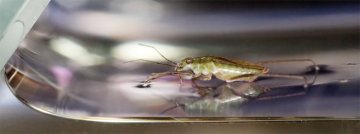To a tiny insect, a pond’s still surface can present a daunting waterscape. To move from water to land, a water-walking creature may have to scale a steep, slippery slope—the curved edge where water meets leaf, rock, or floating object.


The curvature of a liquid’s surface at a boundary is a consequence of the liquid’s surface tension. The sloped surface marking the border between wet and dry is called the meniscus.
To creatures about a millimeter in length, these slopes appear as frictionless mountains. The insects typically can’t climb them using their normal rowing motions or running gaits. If they try to stride up, they slide back down. Instead, these insects have to rely on a novel form of propulsion that doesn’t require moving their legs back and forth.
That’s what mathematicians David Hu and John Bush of the Massachusetts Institute of Technology discovered when they used high-speed video to capture the meniscus-climbing actions of three types of water-walking insect. The researchers describe their findings in the Sept. 28 Nature.
Two species of water strider, for example, have retractable claws on their front and hind legs that allow them to pull up on the water to create tiny peaks. At the same time, the central pair of legs presses down on the water to form dimples in the surface. Because the insects are small, these peaks and dimples create sufficient force to pull the insects up the slope.
In effect, the insect creates tiny menisci with its front and rear legs. Because menisci are attracted to other menisci, the net effect is to pull the insect up the slope at the water’s edge. These creatures can reach speeds as high as 30 body lengths per second.
In technical terms, the insects take advantage of lateral capillary forces that exist between small floating objects, Hu and Bush say. This effect is responsible for the formation of bubble rafts in champagne and the clumping of breakfast cereal in a bowl of milk.
The force of attraction between body and meniscus “wall” depends on the body’s buoyancy and exponentially on its distance from the wall. Because the insect’s front legs are closer to the wall than its rear legs are, the net effect is to propel the insect forward and upward.
In meniscus climbing, the researchers note, instead of moving its legs back and forth, an insect deforms the liquid’s surface, converting muscular strain to the surface energy that powers its ascent.
In the realm of fluid dynamics, few researchers have previously tackled situations that involve surface tension as an important component. The new results and related research may have important applications not only for understanding biolocomotion but also potentially in nanotechnology.






